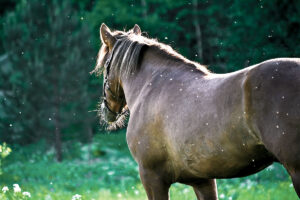Researchers Review the Effects of Hyperflexion on Horse Welfare

Although hyperflexion remains common in horse sports, an equine researcher focused on animal husbandry, behavior, and welfare recently emphasized that scientific consensus correlates riding horses behind the vertical to poor health and welfare. Researchers have found that hyperflexion—when the plane of the horse’s nose falls behind a vertical line—creates physical and mental stress, likely due to musculoskeletal pain, excessive rein tension, hindered eyesight, and possible airway obstruction, said Uta König von Borstel, PhD, a researcher at the University of Giessen, in Germany.
“Our study (a literature review) very clearly shows that hyperflexion is bad for horse welfare, no matter what the circumstances are—full stop,” said König von Borstel, speaking at the 2025 Horse XP Experience for Wellness Conference, held March 15-16, in San Marcello Piteglio, Italy.
The History of Hyperflexion in Horse Sports
Equestrians likely have been riding their horses behind the vertical for hundreds of years—as suggested by artistic drawings in early horsemanship books such as William Cavendish’s Méthode et Invention Nouvelle de Dresser les Chevaux (1658), as well as in paintings and statues of knights and noblemen across several centuries, she said. However, none of the writing in these early texts suggested people should work their horses in hyperflexion.
In competitive dressage hyperflexion became increasingly popular starting in the 1970s, and even more so in the 1990s, in a trend that continues to increase, said König von Borstel.
Officially, the Fédération Equestre Internationale (FEI) suggests dressage judges should prefer horses that keep their nasal plane at or in front of the vertical line. The current rules also place a strong emphasis on constant bit contact, she said. This might lead riders to never release tension—a practice that goes against the principles of ethical horse training “since there’s no striving for lightness,” König von Borstel says.
Studying the Effects of Hyperflexion on Horse Health
Because the topic has led to significant debate—with proponents claiming hyperflexion can improve horses’ range of motion and performance—König von Borstel investigated the body of research on the topic. To do so she teamed up with Andrew McLean, PhD, BSc, Dipl. Ed, founder of the Australian Equine Behaviour Centre, in Victoria, Australia; Kathrin Kienapfel, PhD, of the Swiss National Stud Farm’s Equine Research Group, in Avenches, Switzerland; Christina Wilkins, PhD candidate at the University of New England in Armidale, Australia; and Paul McGreevy, BVSc, PhD, MRCVS, MACVS (animal welfare), professor of animal behavior and animal welfare science at the University of Sydney, in Australia.
Together the researchers searched through all scientific papers published on hyperflexion—which they defined as any head position of any degree behind the vertical. They then selected 58 studies that met their criteria for reliability and robustness.
They found the studies showed negative effects of hyperflexion, such as stress and discomfort related to a forced position and the increased use of rider aids. The researchers had quantified these effects using measurable parameters including increases in heart rate, cortisol (the stress hormone) levels, and conflict behaviors.
Some researchers also reported airway restriction, “which is obviously a condition of serious discomfort for the horse,” König von Borstel said. Some scientists showed hyperflexion limited the horses’ forward vision, which can increase the animals’ anxiety and fear because they cannot clearly see in the direction they’re moving.
Researchers on multiple studies also indicated horses experienced negative results regardless of how long they were held in hyperflexion. “Even short periods in which the horse holds its nose behind the vertical can have negative consequences on its well-being,” König von Borstel said. Likewise, experience didn’t make hyperflexion any more tolerable, she added. “Horses well-accustomed to hyperflexion showed signs of discomfort.”
Even so, in 22% of the studies researchers reported insignificant results or concluded horse welfare had not been compromised, she said. In one study the researchers even suggested positive effects such as reduced stress as measured by heart rate variability after training. However, Koenig von Borstel said this particular study had confounding factors that could make its results less reliable.
Studying Hyperflexion in Equestrian Competition
Researchers on studies included in the review reported that hyperflexion led to better scores at international dressage events, whereas they associated it with poorer scores at low-level shows, said König von Borstel. This has been a progressive trend, she added, with hyperflexion present in 71% of dressage horses in 2008 compared to 45% in 1991 (researchers on one 2022 study included in the review suggested 96.8% of horses are ridden in hyperflexion at some point during international dressage competitions).
On the other hand, at advanced national levels the researchers saw no significant effects of hyperflexion on scores.
In breeding competitions young stallions ridden in hyperflexion received better rideability marks. However, König von Borstel noted the reason was unclear—judges might have viewed them as more obedient, or the horses might have been naturally flexible and adopted position on their own.
Take-Home Message
König von Borstel said the new literature review highlights negative welfare consequences of hyperflexion, including stress, musculoskeletal pain, and hindered vision or respiration, regardless of how hyperflexed the horse is. Although researchers on the reviewed studies did not directly investigate different degrees of hyperflexion, she noted that more pronounced hyperflexion could lead to greater impacts on horse welfare.
The study König von Borstel presented, “Hyperflexing the horse’s neck: a systematic review and meta-analysis,” appeared in Scientific Reports in October 2024.

Related Articles
Stay on top of the most recent Horse Health news with

















